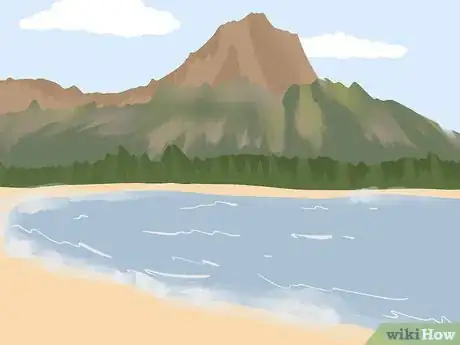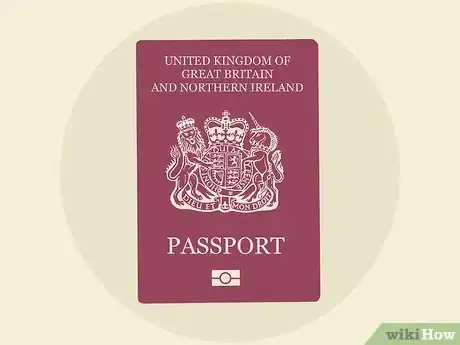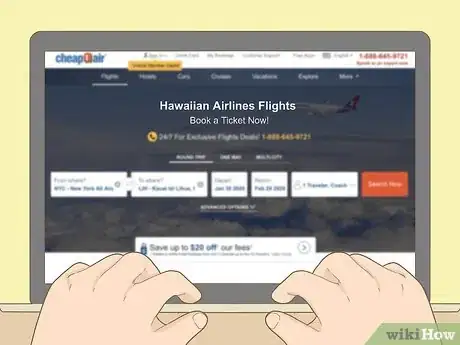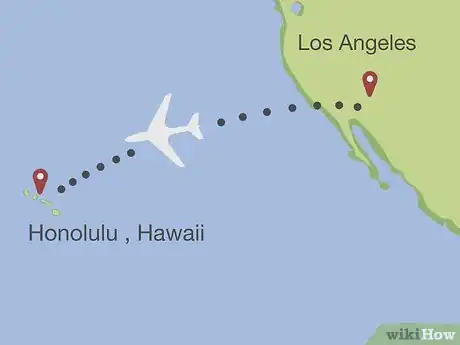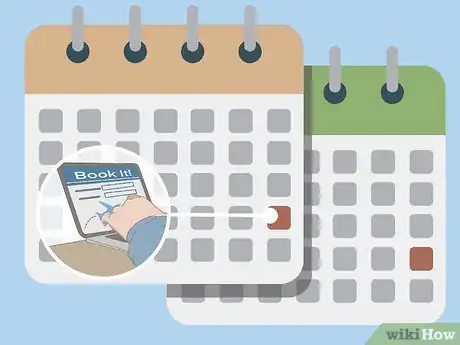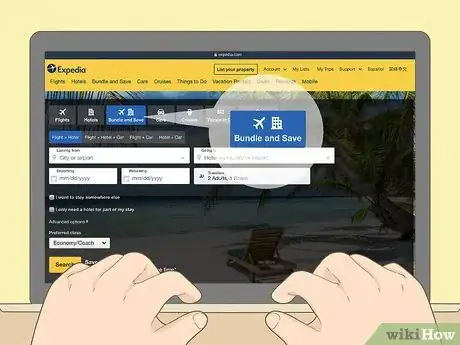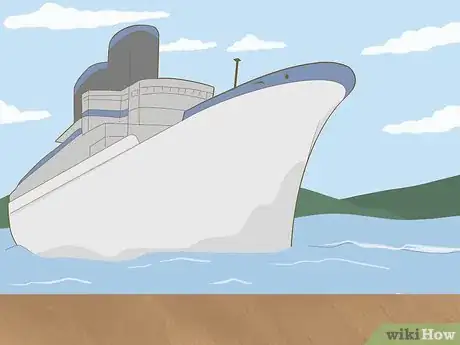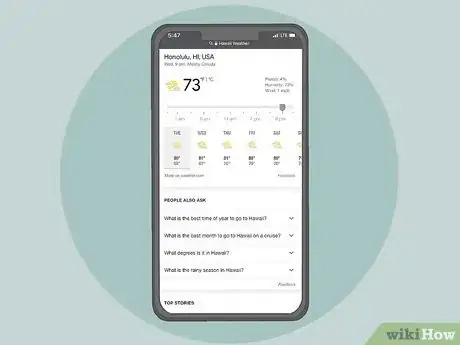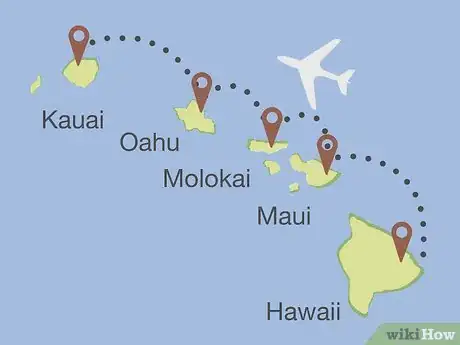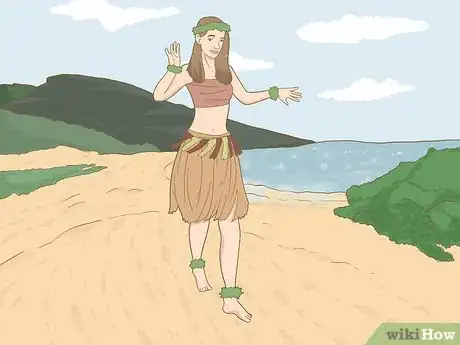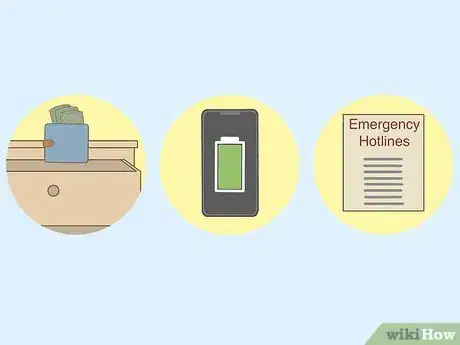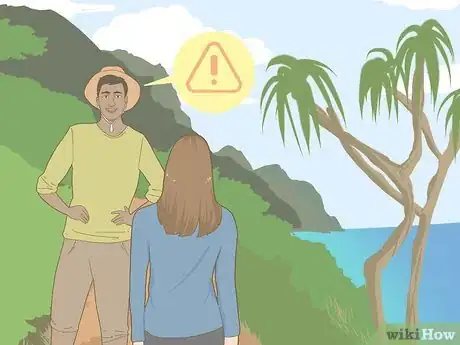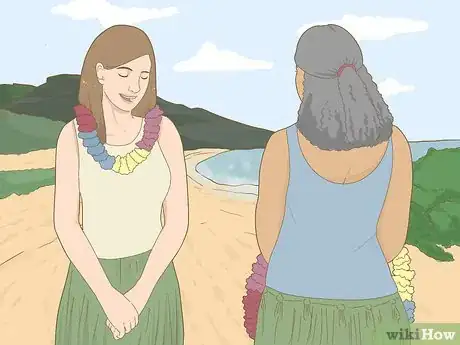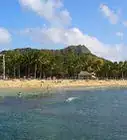This article was co-authored by Alison Hotchkiss. Alison Hotchkiss is an Event Planner and the Founder of Alison Events Planning, Design, and Travel based in Sausalito, California. With over 21 years of experience, she specializes in planning luxury travel for clients in both the honeymoon and leisure travel sectors. Alison Events Planning, Design, and Travel was named as one of Vogue’s best wedding planners around the world and is at the top of the list of wedding planners for Goop, Brides, and Martha Stewart Weddings. Alison received a Bachelors degree from Colorado State University.
There are 28 references cited in this article, which can be found at the bottom of the page.
This article has been viewed 9,281 times.
Hawaii is a beautiful state made up of 7 inhabited islands, 4 of which are the most popular destinations: Hawaii (The Big Island), Maui, Oahu, and Kauai. To plan your trip, consider the dates that work for you and whether you prefer to go during the dry or wet season. Choosing the island (or islands) you want to go to will also help you draft a budget for yourself and your fellow travelers. Flying isn’t cheap, so booking your flight and accommodations early is usually the best choice. Checking the weather a day or two before you leave will help you pack appropriate clothing and gear. Once you’re in Hawaii, kick back and enjoy the stunning natural beauty and friendly “Aloha Spirit!”
Steps
Planning Your Trip
-
1Travel between April and June or September and December to save money. Mid-April through June and September through early December is considered the slow season, which can mean cheaper airfare, cheaper hotel rates, and fewer crowds. However, this isn't a strict rule--you may be able to find discounted rates year-round by booking early or finding a last-minute deal.[1]
- December through mid-April is considered peak travel time in Hawaii because a lot of people are traveling for the holidays or escaping winter weather.
-
2Visit the Big Island to see active volcanoes, mountains, and beaches. The Big Island hosts a range of outdoor sites and activities because it covers 11 different climate zones. From rainforests and waterfalls to white-sand beaches, snow-capped mountains, and volcanoes—you'll find plenty of adventure![2]
- A flight from Honolulu to Kona only takes 45 minutes.
- Consider taking a helicopter tour over Kilauea for stunning views of the world’s most active volcano.
Advertisement -
3Watch whales and relax on the beach in Maui. Maui is a great choice if you like a good balance of beach lounging, historical sites (like Lahaina Town and Iao Valley State Park), nightlife, and whale watching. Maui also has more access to amenities, which is a plus. There's also an incredible view you'll get from the twisting and turning Hana Highway.[3]
- Some airlines fly directly to Kahului from the western U.S., but if that doesn’t work for you, you can also hop on a 45-minute flight from Honolulu to any one of the 3 airports on Maui: Kahului Airport (the main hub), Kapalua Airport (in West Maui), or Hana Airport (in East Maui).
- Check out Waianapanapa State Park to see a black sand beach.
-
4Go to Oahu to enjoy shopping, nightlife, surfing, and historical sites. Oahu is home to Honolulu, the largest city in Hawaii, and will give you the luxury and modernity of any big city along with the natural beauty of its beaches, mountains, and poignant historic sites like Pearl Harbor. If you're looking to learn how to surf, Waikiki beach and the North Shore are famous for their surf-perfect waves.[4]
- Staying in Oahu is a great budget-friendly option if you only have a few days for vacation and don’t want to spend more time traveling.
-
5Stay in Kauai to see stunning waterfalls, beaches, and explore hiking trails. Kauai is known for its breathtaking waterfalls (particularly Wailua Falls), hiking trails (like the Kalalau Trail), and beaches (like Poipu Beach). The island is also home to Waimea Canyon, which is often referred to as the "Grand Canyon of the Pacific."[5]
- You can fly directly to Kauai from Los Angeles or take a short 40-minute flight from Honolulu to Lihue.
-
6Plan a budget for transportation, accommodations, food, and entertainment. Start with the biggest expenses like airfare and accommodations and work your way to smaller spending like dining, entertainment, and land transportation. It's also important to factor in discretionary funds if you plan to shop, take guided tours, or travel to different islands. A 6-day trip for 2 people might look something like this:[6]
- Round-trip airfare: $600 per person = $1,200 total
- Hotel or rental cost: $200 per room x 6 days + $30 hotel tax = $1,230 total
- Dining and entertainment: $80 per person, per day = $960
- Transportation (rental car, taxis, rideshares): $40 per day = $240 total
- Discretionary funds (shopping, tours, island ferries): $40 per person, per day = $240 total
-
7Make a list of all the things you want to do and see. Whether you're a first-time tourist or a seasoned visitor, making a loose itinerary will help you utilize your time most efficiently when you're there. Search online for sites and activities that interest you and make a list in a journal or note-taking app.[7]
- For instance: 1) Go snorkeling in Shark’s Cove; 2) Take a helicopter tour of Kilauea; 3) Eat at Duke’s Waikiki, 4) Go to the Hale Koa Luau.
- To create a visual guide, print out a map and circle places you’d like to go.
- Don’t feel like you need to schedule your days down to the hour (unless you want to).
Booking Your Travel and Accommodations
-
1Get your passport 4 to 6 weeks before your flight, if necessary. If you're not a U.S. citizen, apply for a passport at least 4 to 6 weeks ahead of time at your government embassy. If your passport is expired, you may be able to renew it online (and pay a fee) depending on your country's laws. U.S. citizens can simply show a driver’s license or other government-issued photo-identification.[8]
- Different countries may require your child under 16 or 18 years of age to have a child or adult passport, so check ahead of time if you're traveling with teens or children.
- Make a photocopy of your passport and pack it in a safe place in case you lose your passport on your trip.
-
2Book your airfare 1 to 3 1/2 months early to get the best deals. Flight costs typically go up 2 weeks to 1 month before the date, especially if it's the peak travel season. If you're traveling internationally, your best bet is to book your flight 2 to 6 months ahead of time.[9]
- Use a booking site like Kayak, Expedia, Orbitz, or CheapOair to find discount flights from cheaper airlines.
- Use frequent flyer miles if you have them.
- Be flexible with your dates—flying on Tuesdays and Wednesdays is typically cheaper than flying on other days of the week.
-
3Take a nonstop flight to Oahu, Kauai, or Maui via Hawaiian Airlines. Hawaiian Airlines is a great choice from the west coast and elsewhere in the U.S. because they have direct flights from Boston, Las Vegas, Los Angeles, New York, Phoenix, Portland, Sacramento, San Diego, San Francisco, San Jose, and Seattle.[10]
- Hawaiian Airlines also offers flights between the islands, including less-busy ones like Lanai and Molokai.
- Alaska Airlines, United Airlines, American Airlines, and Delta Airlines also offer direct flights to Oahu (Honolulu) from the west coast and some major hubs (like Chicago and Houston).
-
4Make a connection in Los Angeles for the most flight options. Almost all major airline carriers that fly to Hawaii (Honolulu Airport - HNL) go through Los Angeles. Most of the flights depart anywhere from 7:00 AM to 5:00 PM, but you can find a cheap red-eye if you don't mind arriving late or in the early morning hours.[11]
- The flight from Los Angeles lasts 6 hours, so there's time for a long nap!
- From November through March, the time in Hawaii is 2 hours behind the west coast (otherwise, it's 3 hours), so consider the time change if you're flying with children.
-
5Reserve your accommodations at least 1 month in advance. Hotel prices go up the closer you get to the date, so it’s best to book early. If you’re going for the holidays or during peak travel season, you may want to book your hotel right after booking your flight.[12]
- The lowest average booking rates typically show up 21 to 28 days before the date of arrival.
-
6Find licensed short-term rental properties online. Sites like Airbnb, HomeAway, and Vrbo are a great place to search for short-term rentals. However, different islands and counties have different rules about short-term rentals, so it’s best to make sure the host has a permit. A permit can provide financial protection in case the host or property doesn’t meet the rental agreements.[13]
- A rental property is a great option if you want to stay away from tourist traps.
- Look for a rental property with a kitchen so you can cut down on dining costs by cooking your own meals. As a plus, you’ll gain experience using fresh, local ingredients you may not be able to find back home!
-
7Book your airfare and accommodations together to save money. Travel packages on sites like Expedia, Booking.com, and Orbitz often offer cheaper rates for booking your airfare and hotel together. Do an online search for hotels that are close to your preferred activities (e.g., book something near the beach if you plan to do a lot of swimming or surfing).[14]
- If you plan to rent a car, go ahead and bundle it into your package for a cheaper rate.
-
8Take a cruise to Hawaii if you want a longer getaway. Cruises leave from ports in San Francisco, Los Angeles, San Diego and Vancouver. The cruises typically take 15 to 16 nights to get to Hawaii, so this is a good option if you're craving a longer stint of rest and relaxation![15]
- Depending on your cabin selection, cruise prices can vary from $1,200 to $4,500 (and up).
- As an alternative, you can fly into Honolulu and take a 7-day cruise around the islands.
-
9Buy travel insurance to cover theft, cancellations, and medical problems. Travel insurance isn’t necessary, but it’s helpful if you or someone your traveling with has chronic medical conditions or if you’re traveling during hurricane season (June to November). Read the fine print to make sure the insurance covers hospital visits and emergency flights.[16]
- Most types of traveler’s insurance covers the costs of travel cancellations and delays as well as lost, stolen, or damaged luggage.
Getting Ready for Your Trip
-
1Check the weather 1 or 2 days before your trip. The dry season is from April to October, which means the weather is hot and humid. If you're going anytime from November to March, you might experience some rain and sweater-weather at night. However, even the dry season can boast some rain and the rainy season can experience some hotter weather, so it's best to check the forecast.[17]
- Pack a few sweaters and light pants for winter evenings that get down to 65°F (18°C).
- An umbrella, poncho, and rain boots or close-toed shoes may come in handy if the forecast predicts lots of rain.
- Swimsuits, coverups, and flip-flops are useful year-round!
- If you've planned to go hiking, you'll need some sturdy hiking boots, a hat, sunscreen, sunglasses, and other protective clothing.
-
2Arrange a house or pet-sitter if you need to. If you have a lot of things that need tending at home (like particular plants) or if you have pets, make arrangements so those things are taken care of while you’re gone. Ask a friend or family member to take over those duties or search for professional home and pet sitters online.[18]
- If you want to bring a small dog, you’ll need to provide proof of an OIE-FAVN rabies blood test 120 days before your arrival date. The dog must also be microchipped and you and your veterinarian need to complete health-history paperwork and submit it to your local government’s state department.
-
3Pack medications and travel must-haves in your carry-on bag. It’s always wise to pack anything you need like medications, money, a toothbrush, and device chargers in your carry-on in case your checked bag gets delayed or lost. You might also pack a change of clothes in case your bag won’t get to you until the next day.[19]
- If you’re arriving at night, pack a jacket or light sweater in case you need it to and from the airport.
- If you’re traveling with children, be sure to pack snacks and sources of entertainment to keep them busy on the flight.
-
4Plan your first day’s transportation and activities to lower stress. Make arrangements to take a taxi, rideshare, or shuttle from the airport to your hotel or rental home ahead of time so you’re not scrambling to figure it out after the long flight. If you’re arriving in the afternoon or late at night, look up restaurants near where you’re staying to make your first meal as stress-free as possible.[20]
- A taxi from the airport typically costs $35 to $45 depending on traffic and the distance while a local shuttle may cost anywhere from $15 to $25 or more depending on how far you’re going.
- If you’re staying in a hotel or resort, they may offer a free (or discounted) shuttle service from the airport to the site.
- If you get in so late that nearby restaurants are closed, check your hotel to see if room service will be available by the time you arrive.
Enjoying Hawaii
-
1Go island-hopping via plane or ferry, if possible. If you can't decide which island you want to see, spend a day or two hopping between them. You can take a quick flight from Honolulu (Oahu) to Maui, Kauai, or The Big Island via Hawaiian airlines. Or, for a more scenic route, take a ferry.[21]
- There’s no ferry service from Honolulu to Kauai, but a flight only takes 40 minutes.
- You can take a ferry from Maui to Lanai or Molokai. The Molokai Ferry only takes 90 and departs twice a day. The Lanai Expeditions Ferry departs 5 times a day and takes only 45 minutes. Perfect for a full day of serenity and whale-watching!
-
2Learn useful Hawaiian words and practice hula dancing. Try picking up a few Hawaiian words or taking a hula class. Some hotels will offer hula classes or recommend a local class so you can learn. Luaus (Hawaiian feasts where there’s lots of hula dancing) happen regularly on every island and are a great way to experience true Hawaiian culture. Some common words to know:[22]
- Aloha (ah-lo-hah) can be used to say "hello" or "goodbye."
- Mahalo (muh-hah-lo) means "thank you," so use it often!
-
3Practice basic safety to avoid theft or danger. Hawaii is very safe, but if you’re spending time in one of the larger metropolitan cities like Honolulu, you should take the same safety precautions you would take in any other city. Pickpockets are common on beaches and in tourist areas, so be aware of your surroundings.
- Leave any valuables and large amounts of cash in your hotel room safe or hide them somewhere in your rental home. Thieves target rental cars, so don’t leave any cash or valuables in there either if you choose to get one.
- Always keep your cell phone charged in case of an emergency.
- If you’re staying in a hotel, ask someone at the front desk what parts of town you should avoid walking alone at night.
- Keep a list of important numbers handy. The police emergency number is 911 and the non-emergency number is 808-935-3311.[23]
-
4Follow safety precautions during outdoor activities. No matter how good a swimmer you are, the ocean is extremely powerful. Waves can be swift and unpredictable, so don’t go surfing or swimming alone, late at night, or during a storm. If you’re going hiking or taking a guided tour, use common sense and follow the guide’s safety instructions (e.g., stay with the group, watch your footing, don’t climb porous rocks, carry an emergency whistle, don’t approach wildlife).[24]
- Always check the weather conditions before planning to hike, surf, bodyboard, sightsee, or do anything in nature.
- Get information about hiking trails ahead of time so you know where to find emergency stops and other amenities.
- Know your limits when it comes to climbing, hiking at high altitudes, surfing, paddleboarding, and bodyboarding. If it’s your first time trying any new activity, take it easy.
- Keep an eye on the clock when you’re hiking and turn back so you won’t be hiking at night.
-
5Abide by Hawaiian etiquette. Part of traveling is learning how people behave and communicate with each other. Hawaii has a slew of rich cultural practices and a laid-back culture that you, as a tourist, should respect.[25]
- If someone places a lei around your neck, thank them ("mahalo") and wear it proudly. Don't take it off in front of them, even if it's itching your neck.
- If you meet a new friend and they invite you into their home, always take your shoes off before you step through the door.
- Don't try to take black sand or lava rocks—it's considered disrespectful and is believed to bring bad luck!
- Be kind and courteous to locals on the beaches and roadways (i.e., let them pass if you're on a sightseeing drive and don't invade their beach or surf space).
-
6Relax and embrace the "Aloha Spirit.” The “Law Aloha Spirit” isn’t so much a law as it is a cultural way of life on the islands. It emphasizes kindness, unity, humility, patience, modesty, and harmony. People with “Aloha Spirit” are warm, compassionate, charming, and sincere—think of it as the law of being nice![26]
- When you say “aloha” as a greeting or salutation, understand that it means much more than just “hello” or “goodbye.” In a way, you’re saying, “I see you, I respect you, and I wish you the best, my friend!”
Warnings
- Don’t take risks when it comes to natural disasters like hurricanes, storms, and flash flooding. If you’re hiking or swimming and hear thunder, see lightning, or spot storm clouds on the horizon, stay safe and go back to your hotel room or rental.[29]⧼thumbs_response⧽
References
- ↑ http://hawaii-guide.info/planning.your.trip/when.to.go/
- ↑ https://www.hawaii.com/big-island/attractions/
- ↑ https://travel.usnews.com/Maui_HI/Things_To_Do/
- ↑ https://travel.usnews.com/Honolulu_Oahu_HI/Things_To_Do/
- ↑ https://travel.usnews.com/Kauai_HI/Things_To_Do/
- ↑ https://www.govisithawaii.com/2012/08/29/how-much-for-a-trip-to-hawaii-budget-calculator/
- ↑ https://www.mentalfloss.com/article/556490/tips-crafting-travel-itinerary
- ↑ https://travel.state.gov/content/travel/en/international-travel/before-you-go/travelers-checklist.html
- ↑ https://www.cnbc.com/2017/05/11/whens-the-best-time-to-book-a-flight.html
- ↑ https://beatofhawaii.com/best-airlines-for-flights-to-hawaii/
- ↑ https://www.hawaii.com/travel/flying-to-hawaii/
- ↑ https://www.businessinsider.com/how-to-get-the-best-hotel-rates-2016-11
- ↑ https://www.hiplanningdept.com/short-term-vacation-rentals/
- ↑ https://www.businessinsider.com/how-to-get-the-best-hotel-rates-2016-11
- ↑ https://www.cruisecritic.com/articles.cfm?ID=2616
- ↑ https://www.lonelyplanet.com/usa/hawaii/safety
- ↑ https://www.gohawaii.com/trip-planning/weather
- ↑ https://www.smartertravel.com/10-things-travel/
- ↑ https://www.travelandleisure.com/slideshows/carry-on-must-haves
- ↑ https://ordinarytraveler.com/save-money-travel-transportation
- ↑ https://www.hawaii-guide.com/content/posts/which_hawaii_island_to_visit
- ↑ https://www.hawaii.com/things-to-do/luau/
- ↑ https://www.hawaiipolice.com/dispatch-911
- ↑ http://www.unrealhawaii.com/2012/07/hiking-safety-in-hawaii/
- ↑ https://www.cnn.com/travel/article/hawaii-ways-to-feel-local/index.html
- ↑ https://www.hawaii.edu/uhwo/clear/home/lawaloha.html
- ↑ http://www.thebus.org/route/routes.asp
- ↑ http://www.honolulumagazine.com/Honolulu-Magazine/December-2016/The-Essential-Guide-to-Local-Fruit/
- ↑ https://www.gohawaii.com/trip-planning/travel-smart/safety-tips

